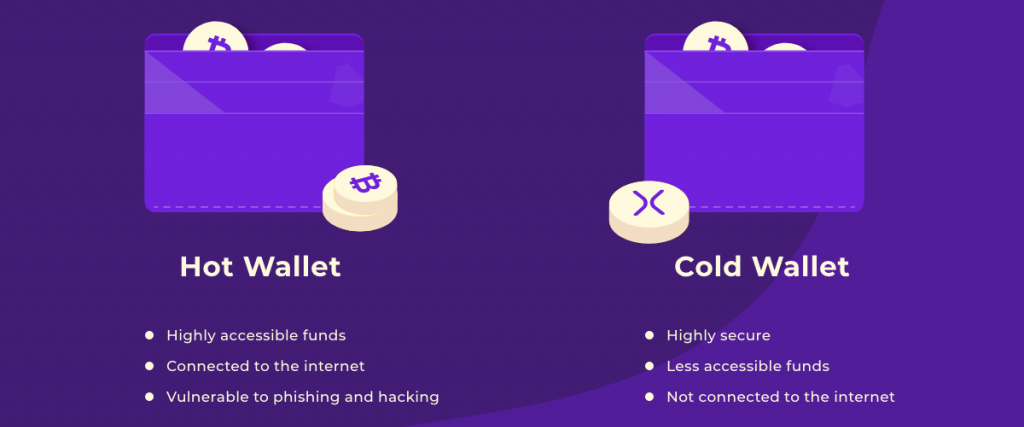Top 3 Cold Wallets to Secure Your Crypto Assets in 2023
2022 has been a shock for many crypto investors, newcomers in particular. When financial events such as the bankruptcy of FTX, a prominent crypto exchange, and the downfall of various major crypto projects and companies happened, an array of crypto platforms abruptly blocked withdrawals – leaving many people dumbstruck.
There is a saying in cryptocurrency circles: “Not your keys, not your money,” which is now more actual than ever. The case with FTX was the latest reminder. This is why all investors need a place where they can store their data safely.
However, most people are not sure which cryptocurrency wallet is best for them. We know how difficult it can be to understand the concept of seed phrases, private keys, and wallet addresses. In this article, we will describe cold wallets, how they work, and how they compare to hot wallets. Then we will discuss the best cold wallets to use in 2023. Let’s dive in!
What is a Crypto Wallet?
Modern crypto wallets provide a reliable method for crypto holders to deposit their private and public keys and manage them there. Once they do so, it means that they are part of a vast blockchain-based cryptocurrency network. As more innovative solutions appear every year, some advanced wallets even provide direct access to decentralized applications and the ability to purchase and sell crypto assets.
Now, remember that the exchange of cryptocurrency does not correlate to the ‘sending’ of crypto tokens from one person’s device to another. These transfers are instead signed with your private key and transmitted to the blockchain network by your private key. When the network receives your transaction, it will adjust both your and the recipient’s address records to show the updated amount of assets.
Actually, it’s a kind of misleading term to call a place to keep cryptocurrencies a “wallet” because digital wallets don’t function like traditional ones. Instead, they provide access to your private keys and the ability to view your public ledger, revealing the number of coins in your wallet.
This is where public and private keys come in. In crypto terms, a key is a very long sequence of characters chosen by the algorithm.
Remember that private keys should always be protected by the owner at all costs, unlike public keys, which can be shared publicly. Confused? Think of it this way: A public key is like an individual’s bank account number, whereas a private key is similar to a password or personal identification number to access it. Also, every public key in cryptography corresponds to a single private key. They function as an encryption/decryption pair.
Why Should People Use Crypto Wallets?

The safety of your cryptocurrencies depends on where and how you store them. While it is also possible to keep cryptocurrency on the exchange itself (mostly on hot wallets), doing so is recommended only if the amount is insignificant to you or if you intend to trade it frequently.
If you’re dealing with a considerable amount of money, it is highly recommended to transfer it into a cold wallet. Thus, you will always be in charge of your funds since you will still possess your private keys, and no one else can access them (unless you lose them).
Cold Wallet: How It Works And How It Compares To Hot Wallet
Since the private key is authenticated “offline,” the problem with online exposure is solved using cold storage. Unless it is physically connected to the device you are using to access your keys, a cold storage mechanism is not interacting with any other electronic equipment. This makes it highly safe.
Prior to being sent to the network, each transaction is moved to an offline wallet where it is digitally “signed.” Say a hacker intercepts the transaction; they still can’t obtain the private key used to sign it since it never touches a server linked to the internet.
If a “hodler” already has some assets stored in a hardware wallet, they can make payments to acquire more assets, and it will look like this:
- The user connects the hardware wallet with a computer that can access the internet.
- To obtain cryptocurrencies, the investor must choose a distribution method. The gadget itself uses complex algorithms to create an address necessary for the transaction.
- Once the address mentioned earlier has been created, the sender can send crypto to it.
- After removing the hardware wallet that stores the investor’s public and private keys, the data is no longer accessible online.
Hot vs. Cold Wallets

Currently, there are two main methods for safely holding your cryptocurrency: hot storage vs. cold storage. Hot wallets are linked to the internet and are hence more vulnerable to theft. This is what cold wallets prevent. But it’s more than that.
A) Cost: Most hot wallets are free to use. It is also free to use the paper wallet; at the same time, most hardware wallets cost hundreds of dollars. This is the cost of safety.
B) User Experience: Hot wallets attract new customers through user experience since they don’t require users to do anything special except connect to the internet. Cold wallets may sometimes be challenging to use, but with time, users get used to them.
C) Security: The main benefit of cold wallets is their robust security. Due to several layers of cryptographic security and other safety measures, cold wallets are incredibly safe and resistant to cyberattacks. Always remember to store your keys in a safe place, though.
Now, let’s take a closer look at the most reliable cold crypto wallets for the next year.
The Best Cold Wallets To Use In 2023

Ledger Nano X
Ledger is one of the most respected and widely used crypto wallets. Unquestionably, the firm behind the Ledger has designed some of the best hardware wallets. The business has been operating since 2014 and has provided investors with a range of high-security goods ever since. Their flagship product, the Ledger Nano X, offers a good combination of practicality and offline protection. A Ledger Nano X looks like a USB device that is linked to a computer using a USB-C cable.
Regarding its features, the Ledger Live software offers several functionalities, such as support for several DeFi applications and exchanges for quick crypto asset purchases.
Ledger is among the best-known brands on the market regarding security. The private keys for the Nano X wallet are kept on the device itself, making it practically unhackable by cybercriminals.
Ledger Nano X can be expensive for some, starting at $149.
Trezor Model T
The next wallet on our list is a modern, security-oriented wallet – Trezor. In 2018, the developer Satoshi Labs unveiled the Trezor Model T, a high-end hardware wallet that became the primary competitor to Ledger.
Its increased security features are what separate it apart from the competition. Users can set up a PIN and passphrase on the wallet to prevent theft of the device. This device requires the confirmation of every single transaction, enhancing the wallet’s safety. They also developed a second internal wallet secured by yet another seed phrase. The assets of the secondary wallet will be secure in this way, even if the physical device is hacked.
The wallet must also be linked through a USB-C connection to function; otherwise, the assets it is keeping will not be unreachable. It takes a while to transmit and access cryptocurrency assets because of the PIN code and 2FA requirements. However, this should be fine for those who prefer robust security.
With a price tag of at least $200, it is also among the most expensive wallets in the market. These drawbacks might not make a difference to serious cryptocurrency investors, given the additional security features the Trezor Model T delivers over other crypto wallets.
ELLIPAL Titan
The ELLIPAL Titan is the first hardware wallet in the world built entirely of metal, which offers enhanced protection against physical attacks. It eliminates network connections, yet is still intended for mobile use.
Actually, the fact that ELLIPAL lacks any physical connection to the internet is a crucial component of this. USB, WiFi, and Bluetooth connections are not available using this wallet. Thanks to QR codes, the hardware wallet transfers data with the smartphone, both compatible with Android and iOS.
ELLIPAL priority is the safety of their crypto wallets. The firm has created a protection system that offers remote help while protecting users from cybersecurity threats.
Since the ELLIPAL Titan is constructed from metal, it is sealed and resistant to dust and water. The wallet cannot be opened without causing significant, long-lasting harm. It is also shielded from brute force physical assaults and hackers by the anti-manipulation function, which also deletes all keys the moment a break-in is discovered.
As of today, there are two main models: ELLIPAL Titan Bundle ($160) and ELLIPAL Titan Mini ($79).
Conclusion
The security and practicality of a crypto wallet should be your top priority when looking for the best wallet to protect your capital. Before choosing a wallet, you should examine all models available, starting with the ones mentioned in this article. Remember that the type of wallet will impact the wallet’s usability, security, supported currency, and overall user experience and compatibility.



